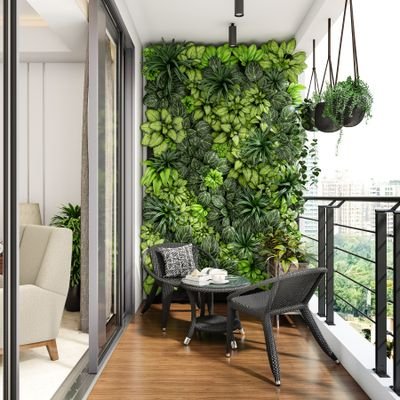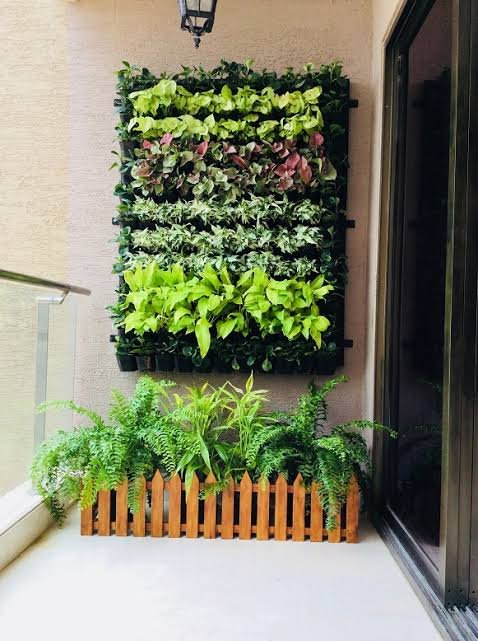Introduction to Vertical Garden
Welcome to our comprehensive guide on creating a vertical garden on your balcony. If you have limited space but a passion for gardening, then delightfully a vertical garden is the perfect solution to maximize your greenery. In this article, we’ll explore the benefits of such type of gardens, provide step-by-step instructions to create your own, and offer valuable tips to ensure your balcony oasis thrives. Let’s dive in!
Balcony design is an important aspect of architectural and interior design, as it contributes to the overall aesthetics, functionality, and enjoyment of a space. A well-designed balcony can serve as an extension of indoor living areas, providing an outdoor retreat and enhancing the value of a property. In this comprehensive answer, we’ll cover various aspects of balcony design, including planning, materials, layout, safety considerations, and additional features.
The concept of such type of gardens dates back centuries, with examples found in ancient civilizations such as the Hanging Gardens of Babylon. However, modern gardens incorporate advanced technology and design principles to create sustainable and visually appealing installations.


1. Understanding the Benefits of Vertical Garden
Space Optimization:
It allow individuals to maximize their use of space, particularly in urban environments where land is limited. They can be installed on exterior walls, balconies, rooftops, or indoor spaces, making them suitable for both residential and commercial applications.
Improved Air Quality:
Plants naturally filter the air by absorbing carbon dioxide and releasing oxygen. Vertical gardens contribute to cleaner air in urban areas by trapping pollutants and reducing dust particles.
Noise Reduction:
The foliage of gardens acts as a natural sound barrier, helping to reduce noise pollution from surrounding areas.
Thermal Regulation:
The plants in a such garden can help regulate temperatures by providing shade and insulation. They absorb and reflect sunlight, thereby reducing the heat island effect in urban areas.
Aesthetically Pleasing:
They add beauty and visual interest to otherwise plain walls or structures. They can be designed in various patterns, textures, and colors, enhancing the overall aesthetic appeal of the space.
Psychological Benefits:
Being surrounded by nature has been shown to have a positive impact on mental health and well-being. Such gardens provide a green and soothing environment, helping to reduce stress and increase productivity.
2. Structure and Components:
Frame or Support Structure:
A sturdy frame or support structure is essential to hold the weight of the plants and ensure stability. It is typically made of materials like metal, wood, or plastic.
Growing Medium:
The growing medium is a material that supports plant growth and retains moisture. It can be soil-based, hydroponic (using water as the growing medium), or aeroponic (using mist or air to deliver nutrients to the plants).
Irrigation System:
An irrigation system is necessary to provide water and nutrients to the plants. It can be automated, ensuring the plants receive the right amount of water at regular intervals.
Plants:
A wide variety of plants can be grown in such gardens, including ornamental flowers, herbs, vegetables, and even small trees. The selection of plants depends on factors such as light availability, climate, and aesthetic preferences.
2. Assessing Your Balcony:
- Evaluate the available space and light conditions.
- Determine the weight-bearing capacity of your balcony.
- Consider any structural limitations and consult with professionals if necessary.
- Choose the right type of vertical garden structure based on your balcony’s characteristics
3.Selecting the Right Plants:
- Opt for plants that thrive in containers and vertical environments.
- Choose a variety of plants with different colors, textures, and heights.
- Consider factors such as sunlight requirements and seasonal changes.
- Popular plant choices for vertical gardens include ferns, succulents, herbs, and trailing vines.


4. Building the Vertical Garden:
Step 1: Prepare the structure
- Research and choose a suitable vertical gardening system.
- Install the framework securely on your balcony wall or railing.
- Ensure proper drainage to prevent water accumulation.
Step 2: Soil and irrigation
- Use a lightweight, well-draining potting mix.
- Install an irrigation system, such as drip irrigation or self-watering containers.
- Consider incorporating a reservoir or watering schedule for efficient plant hydration.
Step 3: Planting the garden
- Start by planting larger plants at the bottom for stability.
- Place smaller and trailing plants higher up to create a cascading effect.
- Allow enough space for each plant to grow and spread.
- Use planters, pockets, or hanging baskets to secure the plants.
5. Maintanance and Care
Site Assessment:
Before installing a vertical garden, it is important to assess the site’s light conditions, climate, and structural integrity. These factors determine the types of plants that can thrive and the necessary modifications to the support structure.
Waterproofing and Drainage:
Proper waterproofing and drainage systems must be in place to prevent water damage to the wall or building structure. Excess water should be drained efficiently to avoid overwatering the plants.
Plant Selection and Placement:
The selection of plants should consider factors like sunlight availability, temperature, and maintenance requirements. Plants are typically arranged in a way that creates an attractive design while ensuring each plant receives adequate light and space for growth.
Maintenance:
They require regular maintenance, including watering, fertilizing, pruning, and pest control. The irrigation system should be monitored to ensure proper functioning, and plants should be regularly checked for signs of disease or nutrient deficiencies.
6.Enhancing Your Garden:
- Add decorative elements like colorful planters or artwork to personalize your space.
- Incorporate vertical garden accessories such as trellises or hanging pots for additional versatility.
- Consider installing LED grow lights to supplement natural light for plants in shaded areas.
Conclusion:
Creating a vertical garden on your balcony opens up a world of possibilities for gardening enthusiasts with limited space. By optimizing vertical surfaces, you can transform your balcony into a lush oasis bursting with life. Remember to carefully assess your balcony, choose suitable plants, build a sturdy structure, and maintain your garden with regular care. With patience and dedication, your garden will flourish, providing you with beauty, fresh air, and a peaceful retreat right at your door step.
CTA (Call to Action): Ready to embark on your gardening journey? Start planning your balcony oasis today and bring nature closer to your home. Share your garden experiences and success stories in the comments below. Happy gardening!



